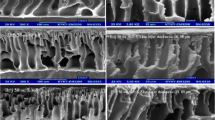Abstract
Purpose
The emulsifiers in an exceedingly higher level are used in the preparation of drug loaded polymeric nanoparticles prepared by emulsification solvent evaporation method. This creates great problem to the formulator due to their serious toxicities when it is to be administered by parenteral route. The final product is therefore required to be freed from the used surfactants by the conventional purification techniques which is a cumbersome job.
Methods
The solvent resistant stirred cell ultrafiltration unit (Millipore) was used in this study using polyethersulfone ultrafiltration membrane (Biomax®) having pore size of NMWL 300 KDa as the membrane filter. The purification efficiency of this technique was compared with the conventional centrifugation technique.
Results
The flow rate of ultrafiltration was optimized for removal of surfactant (polyvinyl alcohol) impurities to the acceptable levels in 1–3.5 h from the nanoparticle dispersion of tamoxifen prepared by emulsification solvent evaporation method.
Conclusions
The present investigations demonstrate the application of solvent resistant stirred cell ultrafiltration technique for removal of toxic impurities of surfactant (PVA) from the polymeric drug nanoparticles (tamoxifen) prepared by emulsification solvent evaporation method. This technique offers added benefit of producing more concentrated nanoparticles dispersion without causing significant particle size growth which is observed in other purification techniques, e.g., centrifugation and ultracentrifugation.












Similar content being viewed by others
Abbreviations
- AICTE:
-
All India council for technical education
- DLS:
-
Dynamic light scattering
- FE-SEM/SEM:
-
Field emission scanning electron microscopy
- GC:
-
Gas chromatography
- HS-GC-FID:
-
Headspace gas chromatography flame ionization detection
- ICH:
-
International conference on harmonization
- IIT:
-
Indian institute of technology
- KDa:
-
Kilo Dalton
- milli-Q:
-
Type I water obtained from Millipore water purification system
- MPCST:
-
Madhya Pradesh council of science and technology
- mV:
-
Milli volt
- ND:
-
Not detectable
- nm:
-
Nanometer
- NMWL:
-
Nominal molecular weight limit
- PDI:
-
Polydispersity index
- PLGA:
-
Poly lactic-co-glycolic acid
- ppm:
-
Parts per million
- PTFE:
-
Polytetrafluoroethylene
- PVA:
-
Polyvinyl alcohol
- RGTU:
-
Rajiv Gandhi technical university
- UV:
-
Ultra violet
References
Baetke SC, Lammers T, Kiessling F. Applications of nanoparticles for diagnosis and therapy of cancer. Br J Radiol. 2015;88:20150207.
Radomska A, Leszczyszyn J, Radomski MW. The nanopharmacology and nanotoxicology of nanomaterials: new opportunities and challenges. Adv Clin Exp Med. 2016;25:151–62.
Couvreurand P, Vauthier C. Nanotechnology: intelligent design to treat complex disease. Pharm Res. 2006;23:1417–50.
Jaiswal J, Gupta SK, Kreuter J. Preparation of biodegradable cyclosporine nanoparticles by high-pressure emulsification-solvent evaporation process. J Control Release. 2004;96:169–78.
Bilati U, Allemann E, Doelker E. Poly(D,L-lactide-co-glycolide) protein-loaded nanoparticles prepared by the double emulsion method--processing and formulation issues for enhanced entrapment efficiency. J Microencapsul. 2005;22:205–14.
Mainardesand RM, Evangelista RC. PLGA nanoparticles containing praziquantel: effect of formulation variables on size distribution. Int J Pharm. 2005;290:137–44.
Murakami H, Kobayashi M, Takeuchi H, Kawashima Y. Preparation of poly(DL-lactide-co-glycolide) nanoparticles by modified spontaneous emulsification solvent diffusion method. Int J Pharm. 1999;187:143–52.
Vandervoortand J, Ludwig A. Biocompatible stabilizers in the preparation of PLGA nanoparticles: a factorial design study. Int J Pharm. 2002;238:77–92.
Kim D, El-Shall H, Dennis D, Morey T. Interaction of PLGA nanoparticles with human blood constituents. Colloids Surf B Biointerfaces. 2005;40:83–91.
Kelly CM, DeMerlis CC, Schoneker DR, Borzelleca JF. Subchronic toxicity study in rats and genotoxicity tests with polyvinyl alcohol. Food Chem Toxicol. 2003;41:719–27.
Halland CE, Hall O. Polyvinyl alcohol nephrosis: relationship of degree of polymerization to pathophysiologic effects. Proc Soc Exp Biol Med. 1963;112:86–91.
Al Khouri Fallouh N, Roblot-Treupel L, Fessi H, Devissaguet JP, Puisieux F. Development of a new process for the manufacture of polyisobutylcyanoacrylate nanocapsules. Int J Pharm. 1986;28:125–32.
Cooperand DL, Harirforoosh S. Design and optimization of PLGA-based diclofenac loaded nanoparticles. PLoS One. 2014;9:e87326.
Cui F, Shi K, Zhang L, Tao A, Kawashima Y. Biodegradable nanoparticles loaded with insulin-phospholipid complex for oral delivery: preparation, in vitro characterization and in vivo evaluation. J Control Release. 2006;114:242–50.
Beck P, Scherer D, Kreuter J. Separation of drug-loaded nanoparticles from free drug by gel filtration. J Microencapsul. 1990;7:491–6.
Dalwadi G, Benson HA, Chen Y. Comparison of diafiltration and tangential flow filtration for purification of nanoparticle suspensions. Pharm Res. 2005;22:2152–62.
Rafieiand P, Haddadi A. Docetaxel-loaded PLGA and PLGA-PEG nanoparticles for intravenous application: pharmacokinetics and biodistribution profile. Int J Nanomedicine. 2017;12:935–47.
Pooja D, Tunki L, Kulhari H, Reddy BB, Sistla R. Optimization of solid lipid nanoparticles prepared by a single emulsification-solvent evaporation method. Data Brief. 2016;6:15–9.
Maji R, Dey NS, Satapathy BS, Mukherjee B, Mondal S. Preparation and characterization of tamoxifen citrate loaded nanoparticles for breast cancer therapy. Int J Nanomedicine. 2014;9:3107–18.
Finely JH. Spectrophotometric determination of polyvinyl alcohol in paper coatings. Anal Chem. 1961;33:1952–7.
Solvent resistant stirred cells for ultrafiltration and filtration applications: user manual. In: Corporation M, editor. Billerica, Massachusetts, USA; 2002.
Q3C(R3) impurities: guideline for residual solvents. Switzerland: ICH Harmonised Tripartite Guideline; 2005, p. 6.
ACKNOWLEDGMENTS AND DISCLOSURES
Authors acknowledge AICTE and MPCST for providing funding, IIT Indore for FE-SEM analysis, and RGTU Bhopal for ultracentrifugation facility.
Author information
Authors and Affiliations
Corresponding author
Rights and permissions
About this article
Cite this article
Paswan, S.K., Saini, T.R. Purification of Drug Loaded PLGA Nanoparticles Prepared by Emulsification Solvent Evaporation Using Stirred Cell Ultrafiltration Technique. Pharm Res 34, 2779–2786 (2017). https://doi.org/10.1007/s11095-017-2257-5
Received:
Accepted:
Published:
Issue Date:
DOI: https://doi.org/10.1007/s11095-017-2257-5




